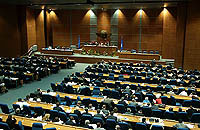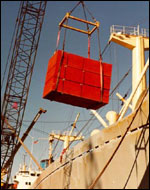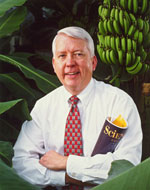All but eclipsed by the somber anniversary of the terrorist attacks of Sept. 11, 2001, the Cartagena Protocol on Biosafety will become international law today with little fanfare. Nonetheless, its entry into force could mark the beginning of a new era in international trade — with potentially sweeping consequences for the environment.

Fields of grain — GMO barley,
to be precise.
Photo: USDA.
The protocol is the first international convention to regulate trade in living modified organisms (LMOs), a subset of the more widely known (and in some circles widely reviled) category of genetically modified organisms (GMOs). It spans 30 pages of definitions, provisions, procedures, agreements, and arrangements, but the most important piece of it is less than a sentence long: an easily overlooked reference, in the preamble, to “Principle 15 of the Rio Declaration on Environment and Development” — a.k.a. the Precautionary Principle.
The Rio Declaration was crafted in the eponymous Brazilian city during the 1992 United Nations Conference on Environment and Development, better known as the Earth Summit. In Principle 15, the international community addresses the perennial problem of how to regulate to protect the environment in the face of massive scientific uncertainty about the causes and consequences of ecological problems. “Where there are threats of serious or irreversible damage, lack of full scientific certainty shall not be used as a reason for postponing cost-effective measures to prevent environmental degradation,” the document proclaims. In other words, better safe than sorry.
Whether or not GMOs pose “threats of serious or irreversible damage” is a question that has polarized the global community. Nations that are net importers of GMOs are increasingly trying to regulate the flood of imports destined for their farmers’ fields and their supermarkets’ shelves; net exporters of GMOs are crying foul. The debate has reached the chambers of the World Trade Organization, where the U.S. — which is not a signatory to the Cartagena Protocol — has brought a suit against the European Union for imposing labeling requirements on genetically altered foods and a moratorium on new genetically modified crops, calling the E.U.’s regulations protectionism in disguise.

Bigwigs met in Montreal in 2000 to
finalize the Cartagena Protocol.
Photo: IISD.
The Cartagena Protocol bolsters the E.U.’s position, because its invocation of the Precautionary Principle affirms the right of nations to regulate biotech imports — such as GMOs — whose environmental and human health risks remain unknown. “This [protocol] is a fundamental step towards better global governance in the GMO field, which is badly needed to maximize the benefits deriving from biotechnology and minimize the risks for the environment and human health,” says Nicola Notaro, an official in the Development and Global Biodiversity Unit of the European Commission.
But at the WTO, the rules are different. Under the Sanitary and Phytosanitary (SPS) Regulations that govern trade in food, imports are considered innocent until proven guilty. “Members shall ensure that any sanitary or phytosanitary measure is applied only to the extent necessary to protect human, animal, or plant life or health, is based on scientific principles and is not maintained without sufficient scientific evidence,” the SPS rules state.
In other words, under the WTO rules, “the burden of proof [is] on the country that wants to have higher standards,” says Kristin Dawkins, vice president for international programs at the Institute for Agriculture and Trade Policy in Minnesota. “Under the Cartagena Protocol, the Precautionary Principle basically reverses those things.”
It remains to be seen whether the newly inaugurated Cartagena Protocol will come into open conflict with the WTO’s existing regulations. But one thing seems certain: Proponents of genetically modified food, led by the U.S. and Canada, will not give up the golden age of unregulated biotech trade without a fight.
Chew on This
How intense of a fight? Well, consider the negotiations that led up to the adoption of the Cartagena Protocol in 2000, which were themselves long and contentious. Since the U.S. did not ratify the Convention on Biological Diversity (the treaty that underlies the Cartagena Protocol), it was not an official party to the development of the protocol. As a trading partner of many countries that did sign on to the protocol, however, the U.S. maintained a keen interest in the proceedings.

Trade to order.
Photo: NOAA.
“If you were to encapsulate this from a U.S. government point of view, we hope that the debate and discussion are based on scientific evidence, rather than hearsay and emotion,” says a senior official with the Bureau of Oceans, Environment, and Science in the U.S. State Department. “Our interests have focused around trying to ensure that when the protocol goes into force, it will not unnecessarily disrupt trade.”
Beth Burrows, founder and director of the Edmonds Institute, a small environment and technology think tank that works to promote more scientific study of the health risks of GMOs, has a different view. “I don’t know that the U.S. has a cogent policy, except to export its own products,” she says. “The U.S. brought quite a large delegation and played quite the bully … throughout the negotiations. It’s like the old joke — what does a 900-pound gorilla eat? Anything it wants.”
At the Cartagena negotiations, the U.S. and the other major GMO exporters (Canada, Argentina, Australia, Chile, and Uruguay) were known as the “Miami Group,” after the location of their first meeting to develop a unified position. Led by the U.S., the group attempted to exclude as many GMOs as possible from regulation, says Dawkins of the Institute for Agriculture and Trade Policy. “There was a while when people referred to this as the ‘Animal Vaccine Protocol,’ because every other type of GMO or LMO was up for exclusion in the U.S. proposal,” she says.

Bananarama: Charles Arntzen
with his vaccine-bearing fruit.
Photo: Cornell University.
In a coup for processed-food exporters, the scope of the treaty was eventually narrowed from all GMOs to only LMOs — bioengineered organisms with viable DNA. The shift in wording excludes most processed foods from the treaty, treating a shipment of corn as an LMO subject to regulation, but exempting cereal made from the same kernels. In another notable exclusion, the protocol does not apply to pharmaceuticals, on the theory that drugs for human consumption are already regulated by other international treaties. However, in the few years since the protocol was finalized, another seemingly science fiction-esque development has edged nearer to becoming fact: crops bioengineered to produce drugs, such as the bananas developed by Cornell scientist Charles Arntzen that contain an edible vaccine for Hepatitis B.
Whether such biopharmaceuticals will be regulated under the protocol remains to be seen, says Dawkins: “That was still far enough into the future that it wasn’t addressed directly. It’s another one of those gray areas that the lawyers can have fun with.”
May the Enforcement Be With You
Although Cartagena becomes international law as of today, many questions remain about its enactment and enforcement.
“On Sept. 11, there are two clocks that start ticking, very important ones,” says Dawkins. “In two years, they’re supposed to come up with detailed regulations on labeling of shipments, which is going to be very hot. And in four years, they’re going to start dealing with the liability issue on an international level.”
The “liability issue” — who pays when biotech experiments go awry — is perhaps the thorniest legal problem in the emerging debate over the regulation of GMOs. Over the next four years, the protocol’s signers will work to decide how to hold GMO manufacturers accountable if their products cause negative environmental, socioeconomic, or human health impacts. This may prove no small feat, particularly as most GMO manufacturers are based in countries that have not signed the protocol. (Cartagena applies to trade between signers and non-signers, but enforcement will likely prove difficult.)

A hard grain is gonna fall.
Photo: USDA.
In the early days of genetically modified crops, biotech companies assured the public that buffer zones around crop fields would prevent GMO crops from escaping into the environment. But for the major GMO crops — corn, soybeans, canola, and cotton — it is proving increasingly difficult to segregate bioengineered varieties from ordinary crops. Genetically engineered genes have shown up in cornfields in remote mountain regions of Mexico, where GM corn has been banned since 1998. In 2000, bioengineered Starlink corn, banned for human consumption because it contained a suspected allergen, found its way into the food stream and prompted a massive recall of supermarket tortilla shells. Canada has already given up on all efforts to grow GMO-free canola because of widespread contamination. Faced with evidence that GMO crops are essentially uncontainable, biotech producers now claim that the escape of bioengineered genes is nothing to worry about.
Tell that to Percy Schmeiser, the Saskatchewan canola farmer who has become something of an international celebrity for standing up to biotech giant Monsanto. Schmeiser’s troubles began when a few bioengineered Monsanto plants showed up in his canola field — according to Schmeiser, the result of GMO pollen drifting from a nearby field. In 1998, acting on a tip from a toll-free, anonymous “snitch line,” Monsanto discovered the plants and sued Schmeiser for patent infringement. Schmeiser promptly slapped Monsanto with a $7.3 million countersuit, claiming that the company had genetically polluted his crops.
Monsanto won the first round. In 2002, a Canadian federal judge ordered Schmeiser to pay $125,000, ruling that he had violated Monsanto’s patent even if the company’s plants had spread into his fields accidentally. Schmeiser has appealed the case all the way to the Canadian Supreme Court, where it will be heard early next year.
Cases like Schmeiser’s reveal the limitations of conventional law when it comes to dealing with patented life forms. On both national and international scales, the question of who pays the price for unwanted gene flow remains unresolved. But in the absence of legislation placing the burden of liability on the shoulders of GMO manufacturers, the costs are likely to be borne by farmers and consumers. And given the difficulty of keeping genes in their proper places, by the time the Cartagena Protocol and all of its liability and labeling laws take full effect, the proverbial genie may be long since out of the bottle.
But regardless of how much environmental impact it will have, says Dawkins, Cartagena is a politically important treaty. “My hope is that it will give more strength of conviction to countries and nations to insist on their sovereign right to regulate these products,” she says.
“The whole point of this thing is … to have some assurances that these GM products are safe,” says Peter Jenkins, an attorney and policy analyst at the Center for Food Safety in Washington, D.C. “I don’t know why anyone would want to argue with that.”



